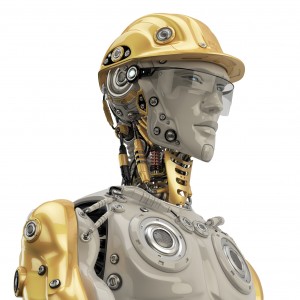Digital Taylorism and Dumb Humans
Years ago, I heard Jaron Lanier give a lecture that included a brief summary of the Turing Test. Lanier suggested that there are two ways that machines might pass Turing’s test of artificial intelligence. On the one hand, machines could get smarter. On the other hand, humans could get dumber.
I wonder if humans-getting-dumber is where we’re headed with digital Taylorism.
Frederick Taylor, who died just over 100 years ago, was the father of scientific management or what we would now call industrial engineering. Working in various machine shops in Philadelphia in the late 19th century, Taylor studied the problems of both human and machine productivity. In Peter Drucker’s words, Taylor “was the first man in recorded history who deemed work deserving of systematic observation and study.” His followers included both Henry Ford and Vladimir Lenin.
The promise of the original Taylorism was increased productivity and lower unit costs. The gains resulted from fundamental changes in human work habits. Taylor-trained managers, for instance, broke complex tasks into much simpler sub-tasks that could more easily be taught, measured, and monitored. As a result, productivity rose dramatically but work was also dehumanized.
According to numerous commentators, we are today seeing a resurgence of Taylorism in the digital workplace. With digital tools and the Internet of Things, we can more carefully and closely monitor individual workers. In some cases, we no longer need humans to manage humans. Machines can apply scientific management to workers better than humans can. (Click here and here for more detail).
Digital Taylorism has spawned an array of devices to measure ever-more-granular work in ever-more-granular detail. Sociometric badges are “…wearable sensing devices designed to collect data on face-to-face communication and interaction in real time.” They could deliver “…a dramatic improvement in our understanding of human behavior at unprecedented levels of granularity.”
More recently, Amazon patented a wristband that can monitor a warehouse worker’s very movement. The wristband can track where a worker’s hands are in relation to warehouse bins to monitor productivity. It can also use haptic feedback – basically buzzes and vibrations – to alert workers when they make a mistake. (Click here, here, and here for more detail).
Could digital Taylorism fulfill Lanier’s suggestion that machines will match human intelligence not because they get smarter but because humans get dumber? Could it make humans dumber?
It’s hard to say but there is some evidence that we did indeed get dumber the last time we fundamentally altered our work habits. Roughly 10,000 years ago, human brains began shrinking. Prior to that time, the average human brain was roughly 1,500 cubic centimeters. Since then, our brains have shrunk to about 1,350 cubic centimeters. As one observer points out, the amount of brain matter we’ve lost is roughly the size of tennis ball.
What happened? A leading hypothesis suggests that our brains began shrinking when we transitioned from hunter-gatherer societies to agricultural societies. Hunter-gatherers live by their wits and need big brains. Farmers don’t. As our work changed, so did our brains.
Could digital Taylorism lead to a new wave of brain shrinkage? It’s possible. In a previous article, I asked what should we do when robots replace us? Perhaps a better question is what should we do when robots manage us?
What Happens When You Anesthetize A Plant?
Some of the best questions about the world around us are those that seem obvious when they’re asked … but anything but obvious until they’re asked.
I recently saw a spate of articles about the use of anesthetics and plants. We’ve known – at least since 1846 – that compounds like ether can anesthetize humans. Breathe a little in and you lose your sensibility to the world around you while maintaining core functions like breathing, heartbeat, and so forth. Simply put, you lose consciousness.
But what would happen if you apply anesthetics to plants, which don’t have hearts or lungs or spinal cords? Would plants also lose consciousness? That would, of course, imply that they are conscious.
It’s an interesting question and — being interested in the history of questions – I wondered if it had ever been asked before. As it happens, a French scientist named Claude Bernard was one of the first to experiment with anesthetics and plants. In 1878, he published Leçons sur les phénomènes de la vie, communs aux animaux et aux végétaux. (You can find the original text here. I discovered it via a 2014 article found here).
Through a series of ingenious experiments, Bernard found that anesthesias such as ether affect plants in very specific ways. For instance:
- Movement – some plants will recoil when their leaf is touched. Under anesthesia, plants lose this ability to move but regain it when the anesthesia is removed. Other movements, however, such as those triggered by light, are not affected. The plant can still move but it doesn’t respond to physical stimuli.
- Germination – under anesthesia, the germination process is interrupted but restarts when the anesthesia is removed.
- Photosynthesis – anesthesia interrupts the photosynthesis process without interrupting the respiration process. Again, photosynthesis restarts when the anesthesia is removed.
In December 2017, researchers published an article in the Annals of Botany that effectively updates Bernard’s experiments. The researchers came to similar conclusions as did Bernard while using a variety of different anesthetics “that have no structural similarities.” They conclude that plants can be an effective research model “to study general questions related to anaesthesia, as well as to serve as a suitable test system for human anaesthesia.”
I find all this fascinating but I also wonder why it has taken almost 140 years to update Bernard’s original research. I think it has to do with our assumptions. We assume that animals – especially animals with spinal cords – are so fundamentally different from plants that we don’t think about comparing them. Carl Linnaeus laid down the rules: there are two kingdoms – the animal kingdom and the vegetable kingdom. Never the tween shall meet. Because of the strict delineation between the two, we haven’t been asking obvious comparative questions, perhaps to our detriment.
It occurs to me that the delineation between animal and vegetable is similar to Descartes’s delineation between mind and body. For Descartes, mind and body were two different universes. Only recently have we discovered how entwined they are. We’re now asking useful and insightful questions about how one influences the other.
I wonder what other useful questions we’re not asking because of our assumptions. Perhaps it’s time to create an encyclopedia of assumptions and begin testing them one by one.
I also think we need to start asking different questions. So many of our questions are about the differences between things. What’s the difference between mind and body? Between men and women? Between different ethnic groups? Claude Bernard, on the other hand, asked about the similarities between animals and plants. Perhaps we should follow his lead. If we asked about our similarities, we might discover that we’re connected in much more profound ways than we imagine.
(The New York Times has a good article on the recent plant experiments, which includes time-lapse photography of plants under the effect of anesthetics. You can find it here.)
Jewelry and Perverse Incentives
With a perverse incentive, a company incents its employees to behave in ways that are contrary to the company’s interests. The company, in other words, pays employees to do things that reward the employee but prevent the company from reaching its stated goals. (See here and here for more detail).
Why would a company do that? Sometimes the stated goals of the company are not its actual goals. For instance, the company may say that it aims to increase customer satisfaction. That’s nice window dressing but the real goal may be to “make the numbers”. So, the company may incent its sale force to act in ways that make the numbers even if such behavior also reduces customer satisfaction. In this example, studying the perverse incentive can help us understand what the company’s real goals are. This seemed to be the case at Wells Fargo, for instance.
In other cases, one business process conflicts with another. Perhaps each process is perfectly fine when running in isolation. When they run in tandem, however, they create perverse incentives. A good example comes from Signet Jewelers, the owner of several retail jewelry chains, including Jared’s, Kay Jewelers, and Zales. (I discovered this case in the business pages of the New York Times. Click here for the original article.)
The Signet situation involves two different business processes: sales and financial credit. By combining the two, Signet created a perverse incentive. Each business process works fine in and of itself. It’s the combination that spawns confusion. Here are the two processes:
- You’re a banker who makes loans to individuals and companies. Your goal is to make profitable loans that are repaid in a timely manner. Your compensation is based on this. If you make a lot of good loans, your compensation goes up. If you make risky loans that aren’t paid back, your compensation goes down. Your incentives line up nicely with the bank’s goals.
- You’re a manager at a retail jewelry chain. You aim to sell more jewelry than you did last month or quarter or year. If you do, your compensation goes up. If you don’t, it goes down. Again, your incentives line up nicely with your company’s goals: to sell more jewelry.
Now let’s change the scenario. You’re now the manager of a retail jewelry store that also offers loans to its customers to enable them to buy more jewelry. Your compensation is based on how much jewelry you sell.
It sounds like a good idea. So, what’s wrong with this picture? To sell more jewelry, you have a strong incentive to give loans to non-credit-worthy individuals. You make the sale, but a relatively high proportion of the loans you make go bad and are not repaid. The company either writes off the loans or spends a lot of money with debt collectors trying to redeem them. The net result is often a negative: you sell more but also lose more.
The Signet example is just one of many. Once you’re familiar with the concept of perverse incentives, you can find them most everywhere, including the morning paper.
Is Loneliness Driving Political Polarization?
Loneliness is a growing problem in modern societies. Political polarization is also a noteworthy trend. Could the two phenomena be linked? Could loneliness, in fact, cause political polarization?
According to numerous sources, loneliness is a serious health problem – not just mental health but physical health as well. Several recent studies have documented the physical effects:
- Julianne Holt-Lunstad and her colleagues analyzed 70 studies and estimate that loneliness increases mortality at about the same rate as obesity or smoking.
- Nicole Valtorta and her colleagues found that being lonely increases your chances of a heart attack by 29% and a stroke by 32%.
- Louise Hawkley and her colleagues found that lonely people are significantly more likely to have high blood pressure.
Additionally, the problem of loneliness is growing. The Harvard Business Review reports that, “Today, over 40% of adults in America report feeling lonely, and research suggests that the real number may well be higher.” The BBC reports that half of adults in England experience loneliness. And it’s not just old people. Julianne Holt-Lunstad’s study suggests, “ the prevalence of loneliness peaks in adolescents and young adults, then again in the oldest old.”
Vivek Murthy, the former U.S. Surgeon General, describes loneliness as an “epidemic”. The United Kingdom has now appointed a minister for loneliness. And Natalie Proulx asks in the New York Times, “Does Every Country Need A Loneliness Minister?”
Shifts in demographics and joining behavior have contributed to loneliness. People today are less likely to belong to church or fraternal organizations. Enrollment in trade unions has declined sharply. Men’s clubs have all but disappeared. Long-term employment with a single company has also declined. The gig economy is perhaps the ultimate expression of the atomized workplace.
If we can no longer find a sense of identity and belonging in traditional identity organizations, where do we turn to alleviate loneliness? Two trends suggest that we may have already moved in loneliness-alleviating directions.
The first trend is that we have sorted ourselves into what might be called “identity neighborhoods.” (Neal Stephenson, in his novel Snow Crash, calls them “burbclaves”). As Bill Bishop pointed out in his 2008 book, The Big Sort, we now segregate ourselves by political identity as much as by class or ethnic identity. Liberals live here; conservatives live there. Our neighborhood can give us a sense of identity and belonging. It also insulates us from opinions that differ from our own. Bishop points out that, “The clustering of like-minded Americans is tearing us apart.” Bill Clinton adds, “Some of us are going to have to cross the street, folks.”
The second trend is the rise of identity politics. We’ve moved away from broad-based political parties and towards “…political positions based on the interests and perspectives of social groups with which people identify.”
Is identity politics driven by loneliness? Simon Kuper thinks so. Writing in the Financial Times, Kuper notes that people are increasingly joining political parties to signal, “…they belong to the same tribe …with a shared identity … and something to talk about. In other words they are doing something that is usually considered positive: they are forging a new kind of community.” If Kuper is right – and I’m inclined to think that he is – then loneliness is the root cause of identity politics.
Loneliness then is not simply an individual issue. It affects the way we organize ourselves in neighborhoods, communities, nations, and political parties. Many observers suggest that identity politics is bad for America – click here, here, and here for representative examples. If we want to stifle identity politics, we first need to work on the problem of loneliness. Perhaps we need a minister for loneliness, after all.
Big Daddy/Big Data
Are older people wiser? If so, why?
Some societies believe strongly that older people are wiser than younger people. Before a family or community makes a big decision in such societies, they would be sure to consult their elders. The elders’ advice might not be the final word but it’s highly influential. Further, elders always have say in important matters. Nobody would think of not including them.
Why would elders be wiser than others? One theory suggests that older people have simply forgotten more than younger people. They tend to forget the cripcrap details and remember the big picture. They don’t sweat the small stuff. They can see the North Star, focus on it, and guide us toward it without being distracted. (Click here for more).
For similar reasons, you can often give better advice to friends than you can give to yourself. When you consider your friend’s challenges and issues, you see the forest. When you consider your own challenges and issues, you not only see the trees, you actually get tangled up in the underbrush. For both sets of advisors – elders and friends – seeing the bigger picture leads to better advice. The way you solve a problem depends on the way you frame it.
According to this theory, it’s the loss of data that makes older people wiser. Is that all there is to it? Not according to Seth Stephens-Davidowitz, the widely acclaimed master of big data and aggregated Google searches. Stephens-Davidowitz has written extensively on the value of big data in illuminating how we behave and what we believe. He notes that companies and government agencies are increasingly trawling big data sets to spot patterns and predict – and perhaps nudge – human behaviors.
What does big data have to do with the wisdom of the aged? Well … as Stephens-Davidowitz points, what’s an older person but a walking, talking big data set? Our senior citizens have more experiences, data, information, stories, anecdotes, old wives’ tales, quotes, and fables than anybody else. And – perhaps because they’ve forgotten the cripcrap detail – they can actually retrieve the important stuff. They provide a deep and useful data repository with a friendly, intuitive interface.
As many of my readers know, my wife and I recently became grandparents. One of the pleasures of grandparenting is choosing the name you’d like to be known by. I had thought of asking our grandson to call me Big Daddy. But I think I’ve just come up with a better name. I think I’ll ask him to call me Big Data.
Seth Stephens-Davidowitz is probably best know for writing the book, Everybody Lies: Big Data, New Data, and What The Internet Can Tell Us About Who We Really Are. He’s also a regular contributor to the Op-Ed pages of the New York Times. I heard his idea about seniors-as-big-data on an episode of the podcast Hidden Brain. (Click here). I mentioned his work a few years ago in an article on baseball and brand loyalty. (Click here). He’s well worth a read.




